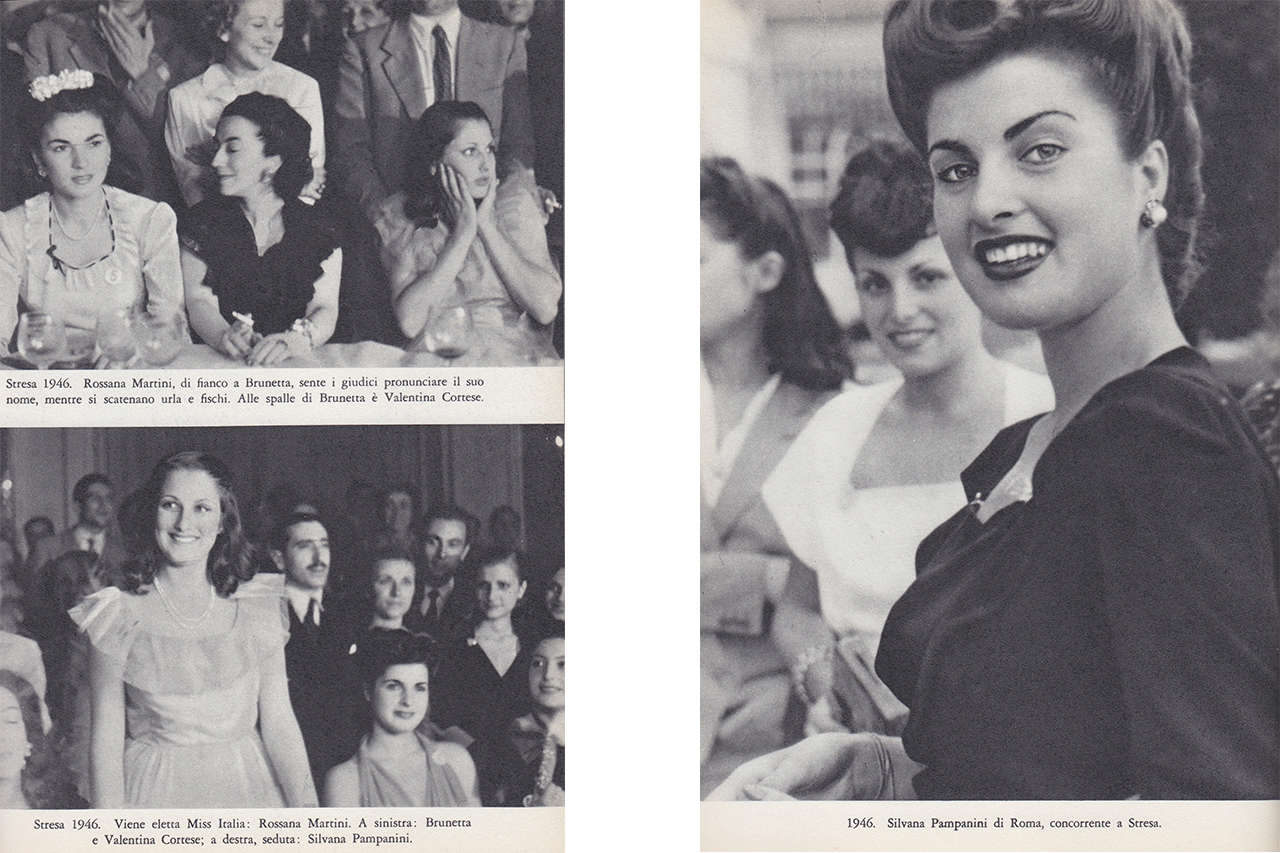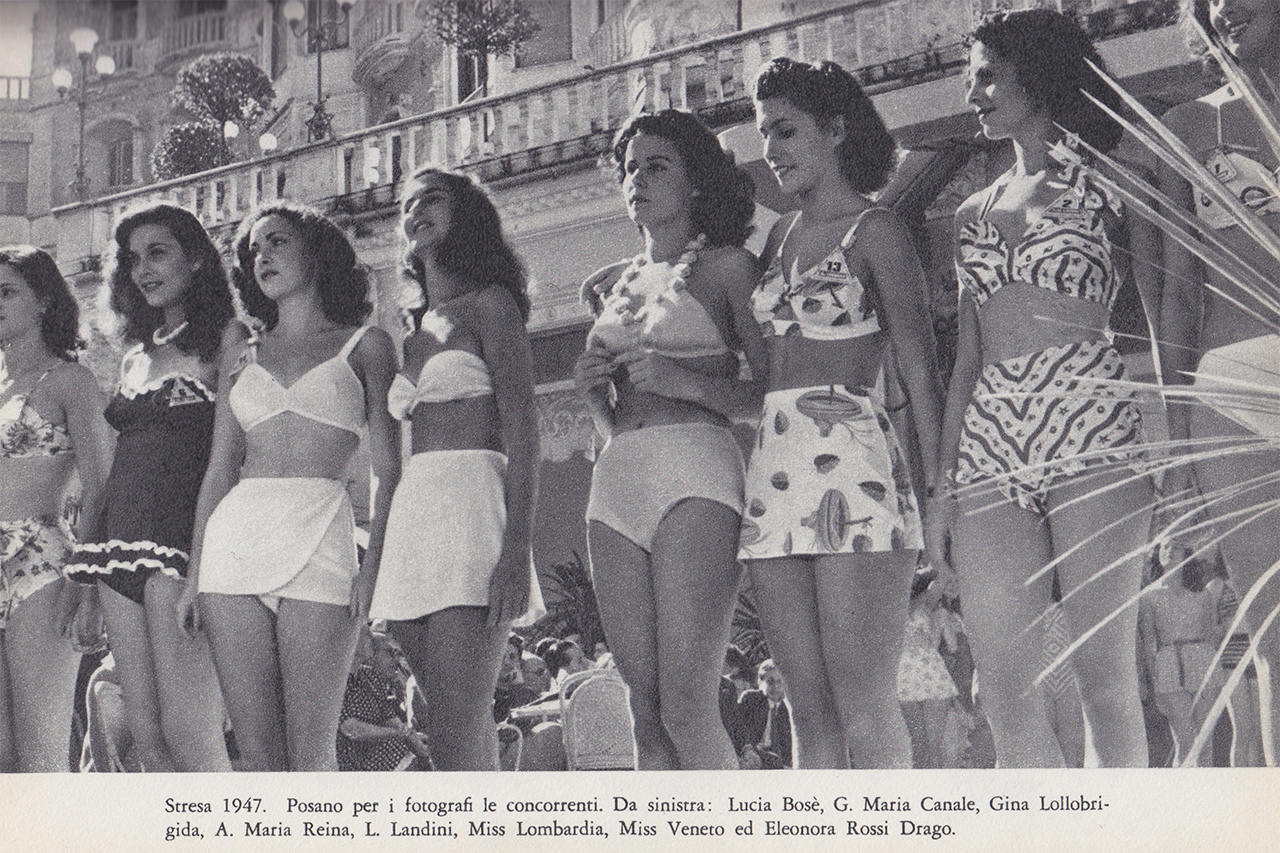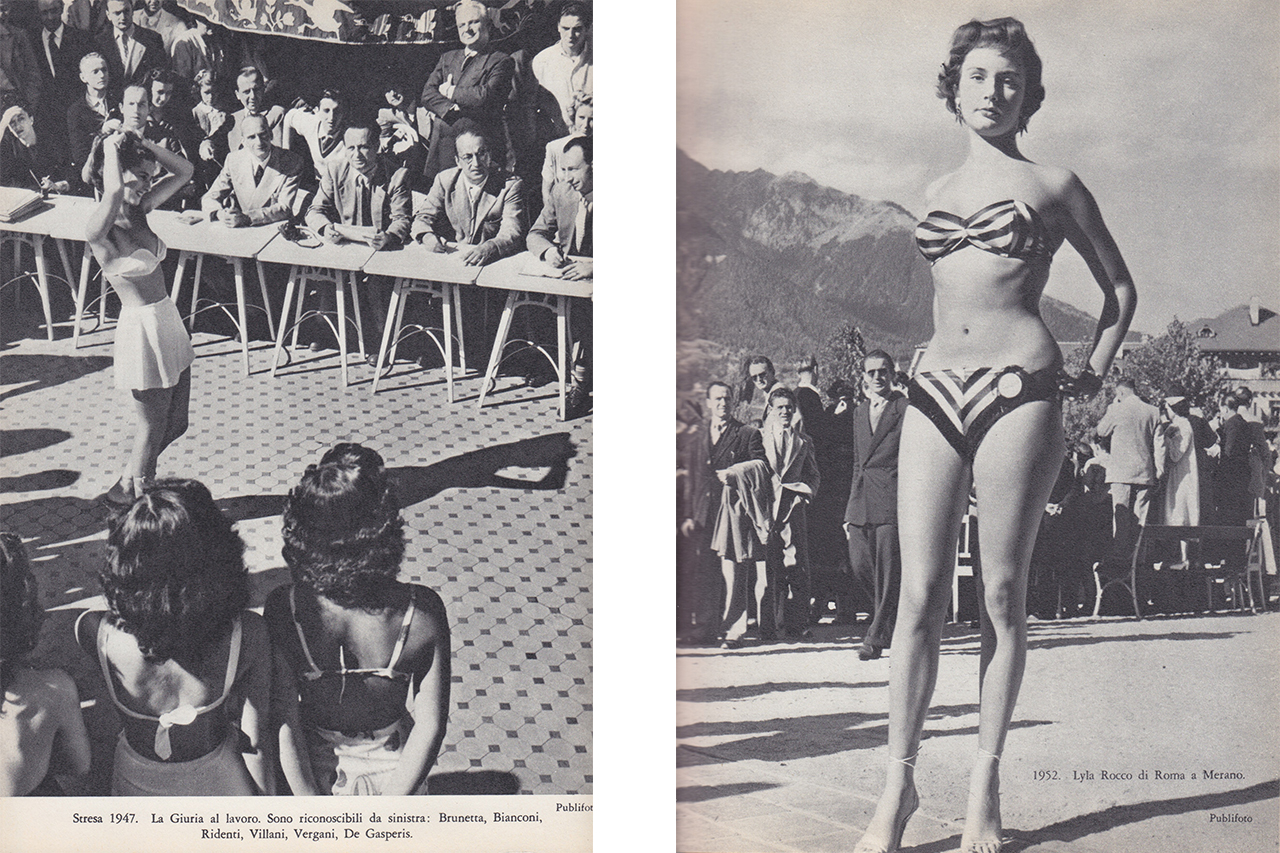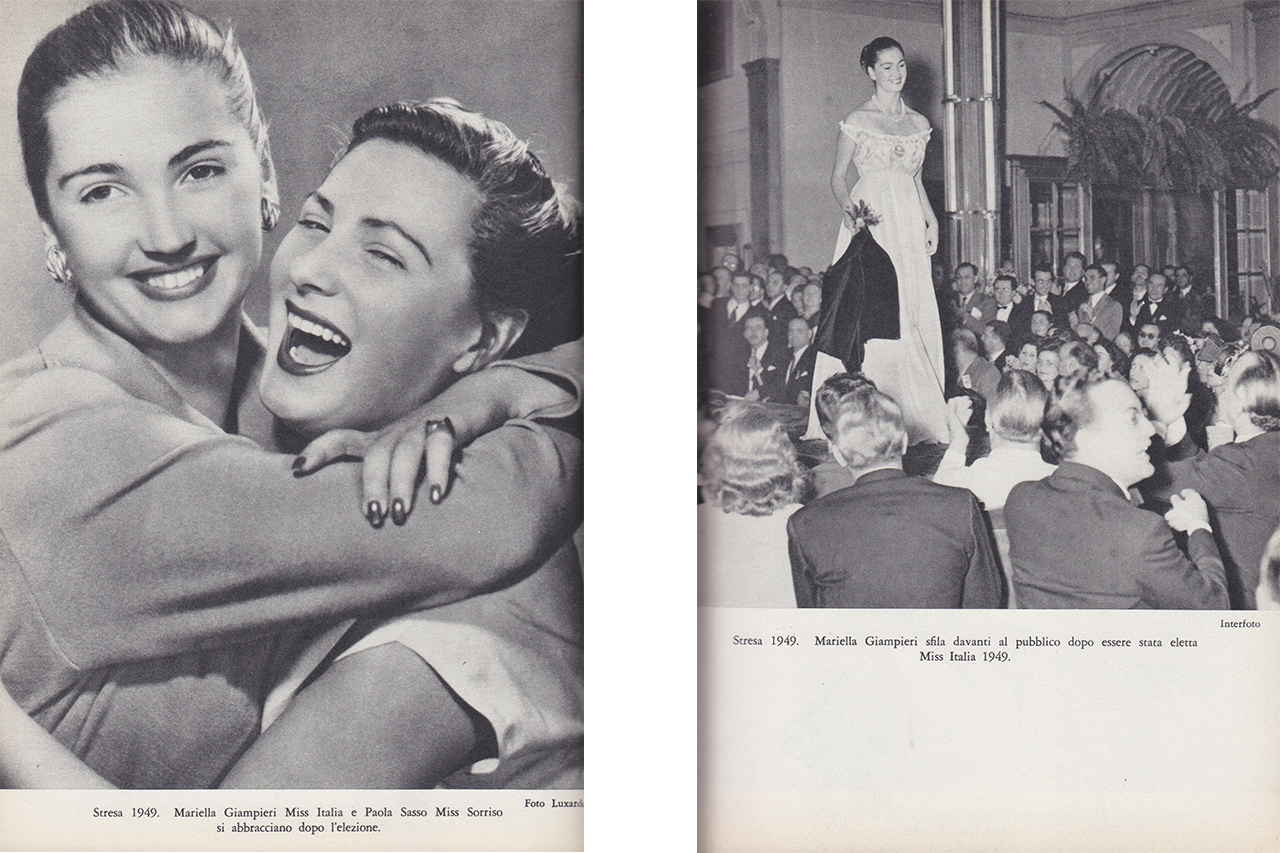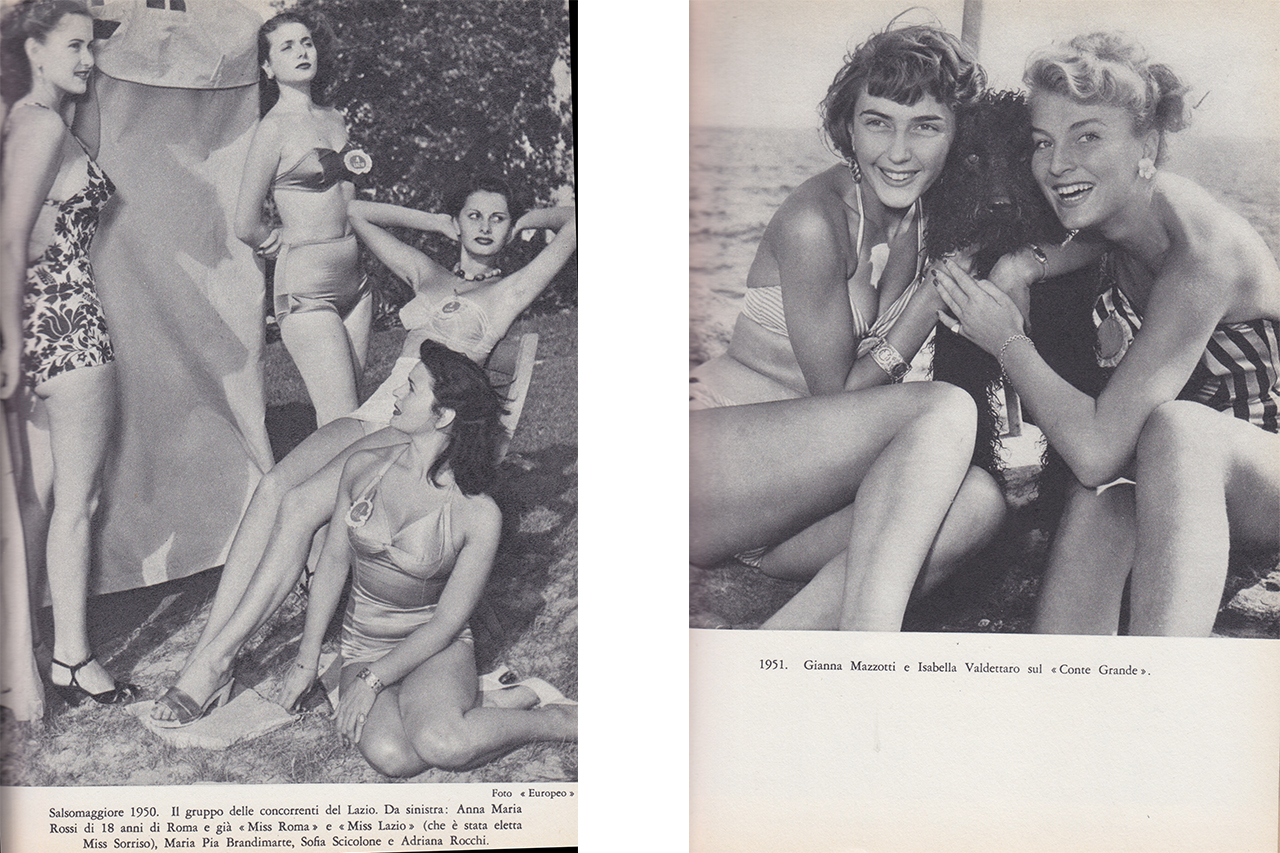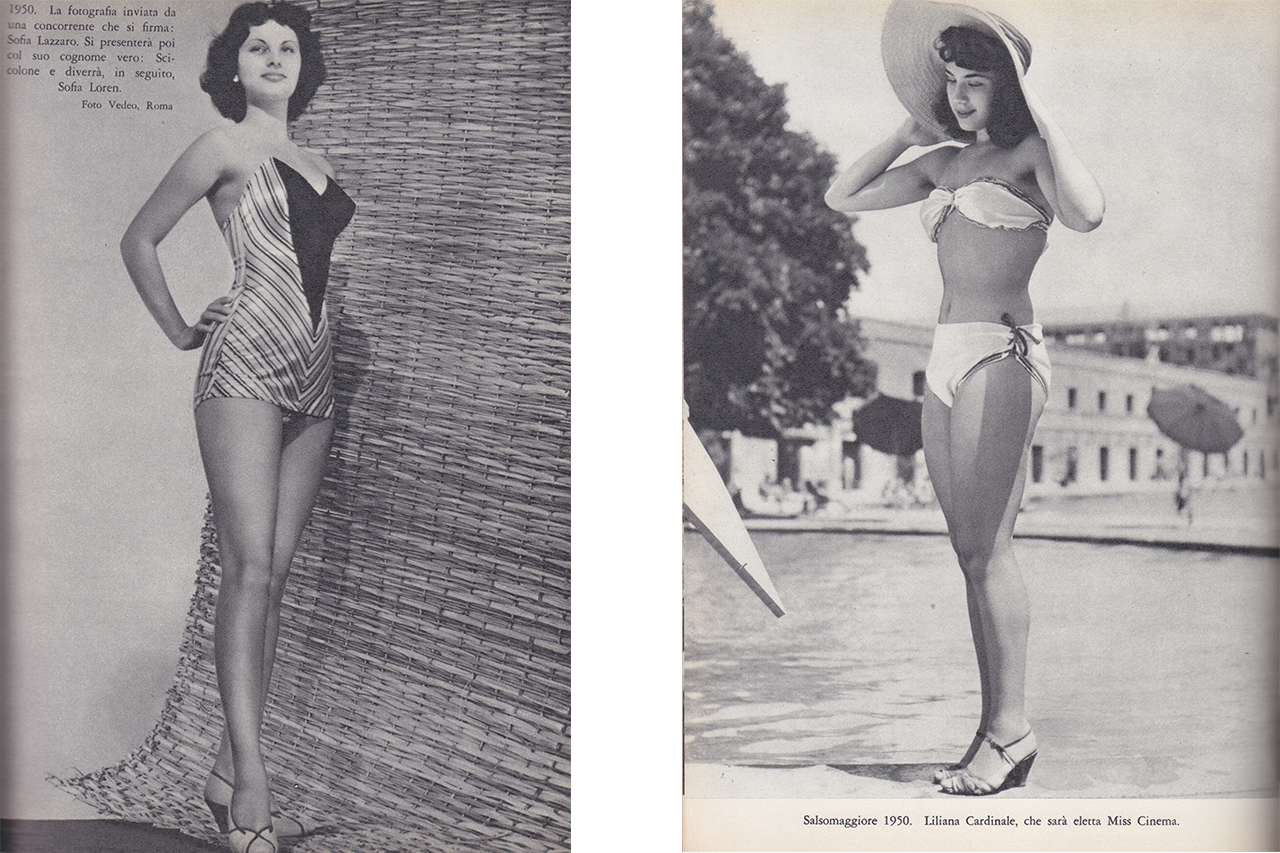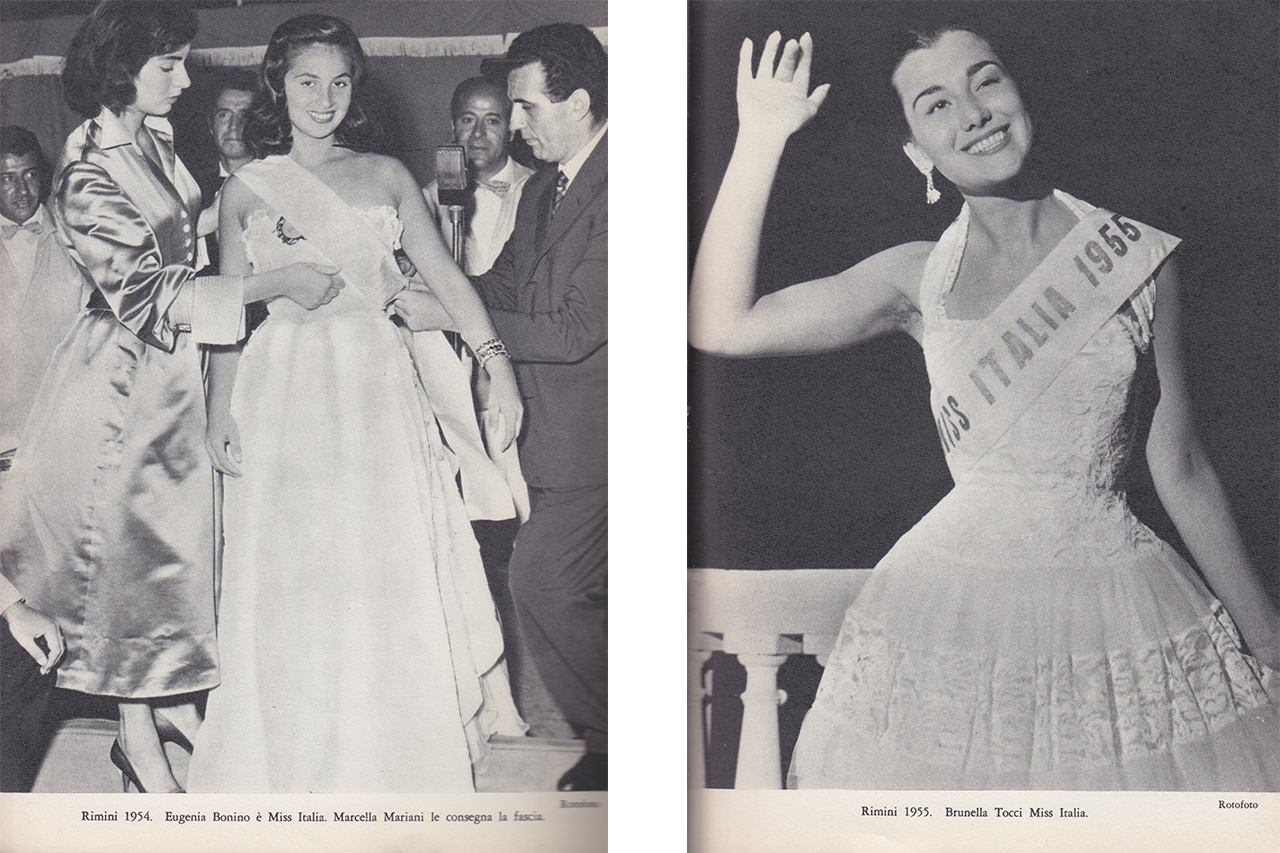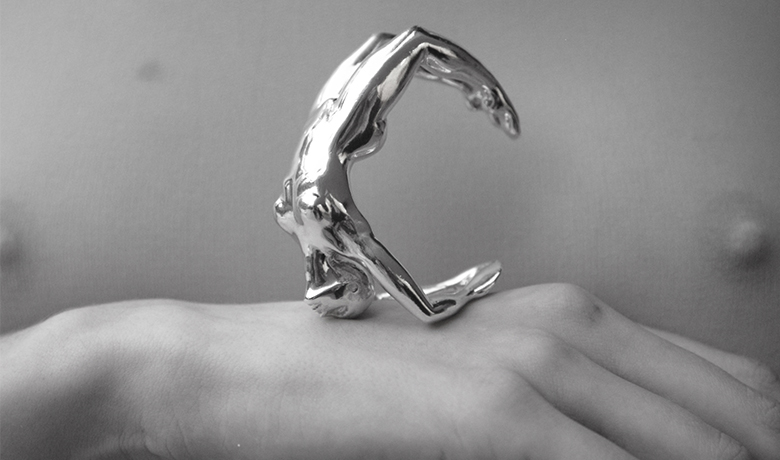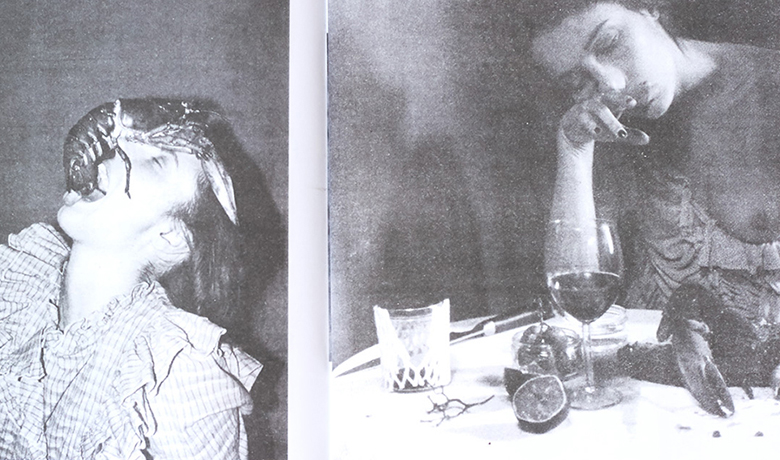#TheItaliaIssue
Let's Talk
PER ME, MISS ITALIA, CONTINUA
// A love letter to a piece of our national popular history.
WORDS BY FEDERICA CIUCI PRIORI
Contests and competitions have always been part of my life.
Not from the agonistic point of view clearly, I’ve never been that sporty.
My afternoons tastes like hairspray, pitch and pear packed juices when every lesson ended. I perfectly remember what the lycra colourful bodies smelled of and the headache provoked by my hair pulled back with such strength from my mother, as if she had to squeeze the water out the cleaning mop.
Then there were the intimate chats in the changing rooms, the habitual breaking of ballet shoes toes, the competitions, the shows and of course the flowers.
Emotions, anxieties and shared moments of happiness behind the scenes, knowing that, no matter if in your village’s piazza or in a theatre in Rome, that would have been the coolest evening of your entire life. That night that your father would have filmed with a camera like every freaking time, until the moment when he will eventually fall asleep between the first and the second half.
I was in ballet school for 16 long and beautiful years, growing up in a naive “bubble” where challenges were constructive, the musical course included in the scholastic year and competitions a must of our Cisternese summer (from Cisterna, a village in the province of Latina). I became completely obsessed with Non è la Rai (an Italian TV show, on air from 9 September 1991 to 30 June 1995) since I was about 4-5 years old (..I was a bit premature I know) then successively Miss Italia got my attention too.
This was way before the conception of feminism was part of my existence.
September didn’t just mean going back to school, it was also climbing the stairs to reach the attic, get into my grandma’s double bed and watch together all the episodes until the big finale, all of this sleeping for one entire week with her (Miss Italia lasted longer than Sanremo back in the old days).
I didn’t know why I was so fascinated by the “kermesse” even if I wasn’t even interested in being in it one day. Although for some reason I wasn’t missing a single edition.
The live part I was enjoying the most was obviously the participants’ interviews.
There was the moment when the “I wish peace for the whole world” was born, the list of the apparent aspirations the girls had, the studies they did, the languages spoken, their attitudes and presumed achieved competences.
While I was growing up Miss Italia’s carousel slowly faded away, it just didn’t seem right anymore. I started forgetting to keep up with the show from 19 on and then I stopped completely watching the show little by little.
But you know, as Antonello (Italian singer-songwriter who became famous in the 1970s for the social themes of his songs) used to sing: “Certi amori non finiscono, fanno dei giri immensi e poi tornano / Some love never ends, they just go round in circles and them come back”. Thanks Antonello.
It really was true, because approximately 4 years ago, I bumped into a 1957 book about my former beloved show in an Italian modernism store and I immediately purchased it, realising that my knowledge about its history was close to 0.
This particular publication was called “Come sono Nate Undici Miss Italia” -(How the 11 Misses Italia were born) – and had been written by Dino Villani who, for the ones who didn’t know, was the precursor of Enzo Mirigliani, the historical patron of the national popular initiative.
Italy,1939.
The Public Security law banished beauty competitions, but with us being Italians, a country known for being great at art and at sorting out things, were never gonna stop in front of this obstacle.
With an admirable invective the Italian newspaper Il Milione launched the competition 5000 lire per un sorriso (5000 lire – the currency at that time – for a smile): anyone, nobody cut out, could send her own smiley photograph to the editorial staff.
Everything was sent. Pictures with children, old people and even horses.
The winning one was of course a young lady, Isabella Verney, age 14, who won not only the title and the cover but also endless public appearances, radio interviews and improvised parades. Italy starts going mad and its desire to identify in a female face starts assuming a concrete dimension.
The initiative lasted few years, war broke out and the newspaper’s section was assigned to the finding of the missing ones.
The nightmare finally ended and in 1946 Dino Villani was back on it: facilitated by a precarious legislative and public security system caused by the post war situation, he launched the first edition of Miss Italia.
There was no television, no live show, just a considerable number of young nubile ladies accompanied by a relative, all of them squished in the hospitality structures of Stresa (the only ones which were still intact after the war), constantly followed for days from a consistent number of journalists, judges, presumed nobles, actors and movie directors. The fight for the first election of the very fist Miss was literally to the death and the last ones to compete against each other were the audacious Silvia Pampanini and the reserved Rossana Martini.
When the situation seemed with no way out one of the components of the jury posed a query in the following terms: “Here in Miss Italia we have to elect the woman who will ideally represent the perfect Italian fanciulla. But the real question is… Do we have to choose the woman to marry and recommend to our own son or the one we wish to be our lover?” (“Come Sono Nate Undici Miss Italia”, Dino Villani). Here you go Dino. You nailed it.
Rossana Martini finally prevailed. Obviously this caused a national protest from north to south. Yes, for how incredible it might sound, even if people couldn’t see the manifestation of a tv screen yet, everyone got so crazy about Miss Italia that they would fight against each other to defend their favorite one like they would do in a Roma vs Lazio football derby.
To cut the long story short the country was now left with two misses, one official and one off-the- record. The population spoke louder than ever, with a voice that was probably more with the lover than with the wife.
This is an ancient story that will replicate often even in future times when second classified girls, guilty of being “too provocative”, will have later on a striking career: Silvana Mangano, Gina Lollobrigida, Sophia Loren and why not… Simone Ventura and Anna Falchi as well!
The first years of Miss Italia proceeded happily: the Misses were popular, cinematographic contracts were signed and prizes and convenient weddings were stipulated. I would like to remember as an exception Miss Italia 1951, Mariella Giampieri, who once having won the title declined any social commitment and asked the money to pay her student fee in Accademia di Belle Arti in Brera, Milan, to follow her dream of becoming a great painter.
Let’s all give a hand to Mariella who chose the canvas instead of the husband.
In 1950 the kermesse was transmitted for the first time on the Radio and on the same year the homonymous movie dedicated to the show was shot.
After we move to 1959 when the “zio” Enzo Mirigliani substituted the good old Dino Villani.
The jury could brag of names like Totò, Giorgio de Chirico, Luchino Visconti, Vittorio de Sica, Alberto Lattuada, Marcello Mastroianni, Ugo Tognazzi, Dino Risi and Alberto Sordi.
The competition became an Institution, “dribbling” with elegance every possible critic received and overcoming the 70’s impetuous feminist movement, maintaining its respect and philosophy collecting numerous awards.
In 1979 the show was finally on TV.
In 1990 the standard ‘sizes’ were abandoned (breast, waist, hips).
In 1994 married participants and mothers were admitted to the show and finally in 1996 Denny Mendez opened doors to black women too.
After many glorious years, the structure started falling into pieces when the first decade of the 2000 ended, until it definitely disappeared from the national cable tv in 2013.
Where did the “I wish peace for the entire Universe”, young ladies dreaming about space, veterinarian clinics or notary deeds went to?
Is it possible that everything vanished slowly with the coming of Striscia la Notizia and the Porto Cervo Sottovento, in a deadly combination of fake blonde highlights, tv guests, vitamins spots and clichés?
Is it possible that all of that couldn’t evolve and find its own space in the world?
Is it really possible that the big audience didn’t support and elect the true contemporary woman with all her defects and went for a prefabricated “ad hoc” stereotyped version of her?
Growing up I finally realised why I was so attracted by Miss Italia.
And no, the reason wasn’t just because it created cult fashion mottos like “So contenta pe fa shta sfilata“ (a broken south Italian dialect version of “I’m happy to partecipate to this catwalk”) – thanks to Sandra Marchigiano, participant of Miss Italia in the World at the end of the 80’s.
But why did it give me this sense of sisterhood, female community with a shared goal, trying to find its own voice thanks to a powerful national channel, seeking to achieve goals,objectives, careers.
In my head they were all smart, beautiful and maybe even if naively, modern super heroines.
I don’t want to say that we played our cards wrong or the system fucked us up, it’s a fact that in 2017 we are still fighting for women rights and protesting against social limits and judgements. There are a lot of great female positive role models today but we are still struggling to celebrate and safeguard them in our “modern” society.
This is unacceptable.
But here’s something I know: in the moment we founded SoapOpera, it kinda became my very own Miss Italia.
A precious tool through which I am lucky to meet and collaborate with beautiful, smart, creative, independent, resourceful, tireless and determined young women.
They inspire me and motivate me to stay here, live in my own country and making something meaningful out of it.
They push me to never give up and take the projects I believe in forward.
The next thing maybe could be Miss SoapOpera, who knows (here comes the podcast!)….
At the end of every single day I say to myself: FEDERICA, MISS ITALIA IS STILL NOT OVER FOR YOU.
But maybe apply a face mask first.
Words by Federica Ciuci Priori.
Translation by Amanda Ballerini.
All the images from “Come Sono Nate Undici Miss Italia”, Dino Villani.
ITA
I concorsi e le competizioni hanno sempre fatto parte della mia vita.
Non in senso agonistico chiaramente, non sono mai stata una sportiva.
I miei pomeriggi erano piuttosto al sapore di lacca, pece e succhi di frutta alla pera a fine lezione.
Ricordo perfettamente l’odore della lycra dei body colorati e il mal di testa provocato dai capelli raccolti a “cipolla” che mia madre tirava a morte neanche stesse strizzando uno straccio.
Le confidenze negli spogliatoi, le punte da rompere, le gare, gli spettacoli e i fiori.
Le emozioni, le ansie e le gioie condivise dietro le quinte e la convinzione che, non importava se nella piazza del tuo paese o in un teatro a Roma, quella sarebbe stata sicuramente la serata più figa della tua vita.
Quella che tuo padre avrebbe ripreso con la videocamera come ogni santa volta, fino a quando non si sarebbe addormentato tra il primo e il secondo tempo.
Ho frequentato la scuola di danza per 16 lunghi e bellissimi anni, crescendo all’interno di una bolla innocente dove le sfide erano costruttive, il corso di musical era nel programma scolastico e i concorsi erano un must dell’estate Cisternese (da Cisterna, paese in provincia di Latina).
Ossessionata da Non è la Rai tra i 4 e i 5 anni (precoce eh), dedicai successivamente la mia attenzione a Miss Italia.
Molto prima che il concetto di femminismo entrasse nella mia vita.
Per me settembre non significava solo tornare a scuola, significava anche salire le scale di casa fino alla mansarda, infilarmi nel letto matrimoniale di mia nonna e guardare con lei tutte le puntate fino alla finale, restando a dormire lì per una intera settimana (ai tempi Miss Italia durava più di Sanremo).
Non sapevo per quale motivo fossi così affascinata dalla kermesse e non sognavo neanche di parteciparvi.
Eppure, per qualche strana ragione, non perdevo negli anni neanche una edizione.
La parte della diretta che amavo di più era, ovviamente, l’intervista alle concorrenti.
La culla di tutti i “voglio la pace nel mondo” mai partoriti, l’elenco delle aspirazioni, dei corsi di studi, delle lingue parlate, delle doti e delle competenze acquisite o presunte tali. Ma, crescendo, la giostra di Miss Italia cominciò ad apparire fuori luogo ai miei occhi. Iniziai a dimenticarmi di seguire la manifestazione dai 19 anni in poi fino a smettere completamente di vederla a poco a poco.
Però si sa, “certi amori non finiscono, fanno dei giri immensi e poi ritornano” (grazie Antonello).
E fu così che, 4 anni fa circa, quando trovai in un negozio di modernariato un libro del 1957 (!!!) dedicato al mio ex programma preferito, lo acquistai subito, realizzando che la conoscenza della storia del concorso, nel mio caso, era pari a zero.
La pubblicazione in questione si chiama “Come Sono Nate Undici Miss Italia” ed fu scritta niente popo di meno che da Dino Villani che, per chi non lo sapesse, è l’antenato di Enzo Mirigliani, storico patron dell’iniziativa nazional popolare.
Italia 1939. La legge di Pubblica Sicurezza vietava all’epoca i concorsi di bellezza, ma noi italiani, simpatico popolo famoso nell’arte dell’arrangiarsi, non ci siamo ovviamente fermati di fronte a questo ostacolo.
Con un po’ di invettiva il giornale “Il Milione” lanciò il concorso “5.000 lire per un sorriso“: chiunque, nessuno escluso, poteva inviare una propria fotografia sorridente alla redazione. Vennero spedite foto di bambini, anziani, addirittura cavalli.
Ad avere la meglio, neanche a dirlo fu una signorina, Isabella Verney, di anni 14, aggiudicatasi, insieme al titolo e alla copertina anche apparizioni in pubblico, interviste radiofoniche e parate improvvisate. L’Italia impazzisce e la voglia di impersonificarsi in un volto femminile inizia ad assumere una dimensione concreta.
Ma l’iniziativa durò pochi anni, scoppiò la guerra e la sezione sul giornale venne dedicata al ritrovamento dei dispersi.
L’incubo finì e nel 1946 Dino Villani ripartì all’attacco: facilitato da un sistema legislativo e di sicurezza pubblico ancora allo sbando post confusione bellica, lanciò la prima edizione di Miss Italia.
Nessuna televisione, nessuna diretta, solo un numero considerevole di signorine nubili accompagnate da un familiare, tutte stipate nelle strutture alberghiere di Stresa (le uniche rimaste in piedi), costantemente seguite per giorni da una miriade di giornalisti, giudici, nobili o presunti tali, registi e attori.
La lotta per l’elezione della prima Miss fu all’ultimo sangue e rimasero in gara l’audace Silvia Pampanini e la timida Rossana Martini.
Quando la situazione sembrava essere senza via d’uscita uno dei componenti della giuria pose il quesito in questi termini: ” Noi dobbiamo eleggere Miss Italia la donna che in un certo senso deve rappresentare l’ideale della fanciulla italiana. Dobbiamo scegliere il tipo di donna che si può sposare e raccomandare di sposare al proprio figlio, oppure quella che si vorrebbe avere come amante?”. (“Come Sono Nate Undici Miss Italia”, Dino Villani).
Tac. Eccerto.
Vinse Rossana Martini. Ma ovviamente tra il dire e il fare c’è di mezzo il mare e da un capo all’altro dell’Italia scoppiò il tumulto. Si, avete capito bene, pur non potendo ancora vedere la manifestazione in televisione, tutti si erano appassionati alle elezioni e si battevano per difendere la propria favorita neanche fosse un derby Roma Lazio. Morale, il paese si ritrovò con due Miss, una ufficiale e l’altra ufficiosa. Il popolo fece sentire la propria voce, una voce che, probabilmente, al figlio avrebbe raccomandato l’amante.
D’altra parte è una storia antica questa che si ripeterà spesso anche in futuro, basti pensare a quante seconde classificate, colpevoli di essere troppo “provocanti”, ebbero poi una carriera folgorante: Silvana Mangano, Gina Lollobrigida, Sophia Loren e addirittura voglio citare anche Simona Ventura e Anna Falchi!
I primi anni della manifestazione trascorsero in maniera felice: le Miss ottenevano visibilità, contratti cinematografici ed ovviamente premi e matrimoni vantaggiosi (goal ambitissimo), ma, per non fare di tutta l’erba un fascio, ricordiamo anche Miss Italia 1951, Mariella Giampieri, che, una volta vinto il titolo declinò ogni impegno sociale e chiese di ricevere in dono il pagamento della proprio retta, determinata a voler frequentare l’Accademia di Belle Arti di Brera per inseguire il sogno di diventare una grande pittrice. Grande Mariella che al marito preferì la tela.
Nel 1950 la kermesse venne trasmessa per la prima volta alla Radio, e nello stesso anno venne girato il film omonimo dedicato alla trasmissione.
Ecco che nel 1959 arrivò zio Enzo Mirigliani che sostituì il buon vecchio Dino Villani. Lo storico della giuria vantò nel tempo nomi di spessore: Totò, Giorgio De Chirico, Luchino Visconti, Vittorio De Sica, Alberto Lattuada, Marcello Mastroianni, Ugo Tognazzi, Dino Risi, Alberto Sordi.
Il concorso divenne una istituzione, dribblò elegantemente le critiche mosse periodicamente qua e là, superò indenne la ventata di femminismo degli anni 70 e proseguì per la sua strada collezionando traguardi.
Nel 1979 approdò in televisione, nel 1990 vennero abolite le misure (seno-vita- fianchi), nel 1994 furono ammesse per la prima volta concorrenti sposate e madri e nel 1996 Denny Mendez aprì finalmente le porte alle Miss di colore.
Eppure, dopo tanti anni gloriosi, l’impalcatura iniziò a cedere e a sgretolarsi lentamente verso la fine del primo decennio degli anni 2000, fino a scomparire definitivamente dalla rete nazionale nel 2013.
Cosa ne è stato della pace nel mondo, delle miss che sognavano lo spazio, gli ambulatori veterinari e gli atti notarili?
Possibile sia tutto stato inghiottito lentamente da Striscia La Notizia e dal Sottovento di Porto Cervo, in un tripudio di meches color ocra, ospitate televisive, spot per le vitamine e luoghi comuni?
Possibile che tutto questo non sia riuscito ad evolversi e che il pubblico della vita non abbia supportato ed eletto la vera giovane donna contemporanea con tutte le sue difficoltà piuttosto che un modello prefabbricato ad hoc?
Crescendo ho capito per quale motivo fossi così attratta da Miss Italia.
E no, non è solo perchè ci ha regalato uno dei motti più famosi nell’ambiente della moda aka “So contenta pe fa shta sfilata” (un abbraccio caloroso a Sanda Marchegiano, Miss italia nel Mondo fine anni 80). Ma perché, a modo suo, mi trasmetteva un senso di sorellanza, di comunità femminile con un obiettivo comune, che sembrava cercare la propria voce tramite uno strumento potente come quello di una trasmissione in onda su frequenze nazionali, per ottenere risultati, traguardi, carriere.
E nella mia testa, erano davvero tutte belle e intelligenti, ingenuamente, delle moderne super eroine.
Non voglio dire che ce la siamo giocata male o che il sistema ci abbia un pò fottute, sicuramente ci ritroviamo nel 2017 a combattere ancora per i nostri diritti di donna e a scontrarci sempre contro giudizi e limiti sociali.
Di riferimenti femminili positivi e grandiosi ce ne sono e ce ne sono tanti, ma continua ad essere difficile celebrarli, imporli, difenderli e salvaguardarli.
E questo è inaccettabile.
Ma una cosa la so: nel momento in cui l’abbiamo creata, SoapOpera è diventata un pò la mia Miss Italia.
Un mezzo tramite il quale ho la fortuna di poter conoscere e poter collaborare con tante bellissime e intelligentissime giovani donne, creative, indipendenti, intraprendenti, instancabili e determinate. Sono loro che mi ispirano, mi motivano a rimanere in nel mio paese, a costruire qualcosa, spingendomi a non mollare e a portare avanti i progetti in cui credo.
Il prossimo, chi lo sa, potrebbe proprio essere Miss SoapOpera (vai col podcast!).
E alla fine della giornata mi dico: FEDERICA, PER TE MISS ITALIA CONTINUA.
Ma se ti fai una maschera è meglio.
Testo Federica Ciuci Priori.
Traduzione Amanda Ballerini.
Tutte le immagini sono tratte da “Come Sono Nate Undici Miss Italia”, Dino Villani.
